Home
 Tunisians value their clothing traditions very much. They still use folk costumes in everyday life. And – what’s more important – they often add some ethnic flavor to modern garments. It helps Tunisians to keep and develop the tradition, to remember their past and look forward to the future. The traditions of the country are so important because that’s what makes the nation unique. Tunisian modern attires on the photos below have such ethnic features as the traditional embroidery patterns, folk headdresses, jewelry typical for this culture, authentic shapes of garments, etc.
Tunisians value their clothing traditions very much. They still use folk costumes in everyday life. And – what’s more important – they often add some ethnic flavor to modern garments. It helps Tunisians to keep and develop the tradition, to remember their past and look forward to the future. The traditions of the country are so important because that’s what makes the nation unique. Tunisian modern attires on the photos below have such ethnic features as the traditional embroidery patterns, folk headdresses, jewelry typical for this culture, authentic shapes of garments, etc.
- Details
- Category: Tunisia
- Hits: 17357
 Morocco is a country with very rich traditions, a great ethnic diversity, and incredible views. But the clothing traditions of Morocco are even more diverse and colorful. While the traditional male clothing is rather simple and has little embellishments, the female garments are ornate, exquisite, and expensive. The folk dress of Morocco is traditionally made from the natural materials. The most interesting fact about the clothing traditions of Moroccans? A lot of women in this country wear hijab just because of the fashion.
Morocco is a country with very rich traditions, a great ethnic diversity, and incredible views. But the clothing traditions of Morocco are even more diverse and colorful. While the traditional male clothing is rather simple and has little embellishments, the female garments are ornate, exquisite, and expensive. The folk dress of Morocco is traditionally made from the natural materials. The most interesting fact about the clothing traditions of Moroccans? A lot of women in this country wear hijab just because of the fashion.
- Details
- Category: Morocco
- Hits: 22369
 For Ukrainians, embroidering is very symbolic. Only women used to embroider because this process was considered sacred – though, today anyone can do it. When a woman is embroidering she scribes the life she wants for the owner of the piece on the fabric. Hand embroidering is a process similar to the meditation. In Ukraine, people believe in the power of embroidering and know how to use this power.
For Ukrainians, embroidering is very symbolic. Only women used to embroider because this process was considered sacred – though, today anyone can do it. When a woman is embroidering she scribes the life she wants for the owner of the piece on the fabric. Hand embroidering is a process similar to the meditation. In Ukraine, people believe in the power of embroidering and know how to use this power.
- Details
- Category: Ukraine
- Hits: 16965
 The tradition of making and using embroidery on fabric in Ukraine is very ancient and strong. Many pieces of the national costume of this country are embroidered (like embroidered shirt called “vyshyvanka”), as well as festive towels (called “rushnyk”), tablecloths, toys, and other household items. There are over 250 embroidery stitches used by the craftswomen. Every region of Ukraine has its own patterns, symbols, traditions, colors, and techniques of embroidering.
The tradition of making and using embroidery on fabric in Ukraine is very ancient and strong. Many pieces of the national costume of this country are embroidered (like embroidered shirt called “vyshyvanka”), as well as festive towels (called “rushnyk”), tablecloths, toys, and other household items. There are over 250 embroidery stitches used by the craftswomen. Every region of Ukraine has its own patterns, symbols, traditions, colors, and techniques of embroidering.
- Details
- Category: Ukraine
- Hits: 35006
 Greek male costume is very interesting. There are several designs of the costume depending on the region of usage. But the most popular and recognizable around the world Greek outfit includes a skirt-like men’s garment called “fustanella”. Here is an example of the male national costume of Greece. It consists of a shirt, a fustanella (skirt-like male piece), a traditional short jacket with sleeves falling freely over the back, a wide fabric sash, white tights, traditional Greek shoes with large pom-poms called “tsarouchia”, and a fez with a tassel.
Greek male costume is very interesting. There are several designs of the costume depending on the region of usage. But the most popular and recognizable around the world Greek outfit includes a skirt-like men’s garment called “fustanella”. Here is an example of the male national costume of Greece. It consists of a shirt, a fustanella (skirt-like male piece), a traditional short jacket with sleeves falling freely over the back, a wide fabric sash, white tights, traditional Greek shoes with large pom-poms called “tsarouchia”, and a fez with a tassel.
- Details
- Category: Greece
- Hits: 27224
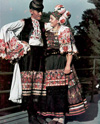 The folk costume of Hungary is rather diverse; it differs from the other Eastern-European national dresses. The Hungarian traditional outfit has a lot of Renaissance and Baroque features. But until the beginning of the 20th century, the folk clothing of Hungary was simpler and had fewer decorations. Only in the 1930s, colorful threads were added to the patterns, and the amount of embroidery was increased. Today, Hungarian folk dress is rarely used by locals. Though, it still is unique and outstanding.
The folk costume of Hungary is rather diverse; it differs from the other Eastern-European national dresses. The Hungarian traditional outfit has a lot of Renaissance and Baroque features. But until the beginning of the 20th century, the folk clothing of Hungary was simpler and had fewer decorations. Only in the 1930s, colorful threads were added to the patterns, and the amount of embroidery was increased. Today, Hungarian folk dress is rarely used by locals. Though, it still is unique and outstanding.
- Details
- Category: Hungary
- Hits: 72000
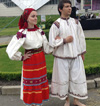 Many modern young people in Ukraine are fond of the national costumes of this country. Of course, you can buy a modern embroidered shirt called “vyshyvanka” without any efforts at all. But in Ukraine, today it is prestigious and stylish to have a full set of authentic clothing: a shirt embroidered by a great-great-granny, garments made from a homespun cloth, vintage hand-woven pieces, etc. Here is a nice modern fashion show of vintage Ukrainian outfits organized by several students. All the costumes were collected in different villages around the country piece by piece.
Many modern young people in Ukraine are fond of the national costumes of this country. Of course, you can buy a modern embroidered shirt called “vyshyvanka” without any efforts at all. But in Ukraine, today it is prestigious and stylish to have a full set of authentic clothing: a shirt embroidered by a great-great-granny, garments made from a homespun cloth, vintage hand-woven pieces, etc. Here is a nice modern fashion show of vintage Ukrainian outfits organized by several students. All the costumes were collected in different villages around the country piece by piece.
- Details
- Category: Ukraine
- Hits: 29577
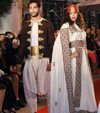 Algerian fashion is very unique. It was formed by the influence of three different civilizations: Arab, African, and Mediterranean. The geographical position of Algeria historically was the cause of culture mixing: meetings, trading, and exchanges between three worlds were common. No wonder, Algerian clothing traditions are so rich and diverse.
Algerian fashion is very unique. It was formed by the influence of three different civilizations: Arab, African, and Mediterranean. The geographical position of Algeria historically was the cause of culture mixing: meetings, trading, and exchanges between three worlds were common. No wonder, Algerian clothing traditions are so rich and diverse.
- Details
- Category: Algeria
- Hits: 127817
 Ukraine treasures its clothing traditions very much. The exhibitions of vintage embroidered garments and folk costumes are often held in this country. In some cases, such exhibitions can be ordinary and even a little dull but there are exceptions. A few days ago Ukraine had an international festival of traditional cultures called “Ethnoworld”. One of the items presented at that event was a collection of vintage embroidered women’s shirts. The pieces themselves were extraordinary but the presentation was even more striking.
Ukraine treasures its clothing traditions very much. The exhibitions of vintage embroidered garments and folk costumes are often held in this country. In some cases, such exhibitions can be ordinary and even a little dull but there are exceptions. A few days ago Ukraine had an international festival of traditional cultures called “Ethnoworld”. One of the items presented at that event was a collection of vintage embroidered women’s shirts. The pieces themselves were extraordinary but the presentation was even more striking.
- Details
- Category: Ukraine
- Hits: 14598
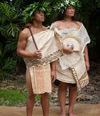 If you still think that Hawaiian national costume consists of a coconut bra and a grass skirt, this article is for you. The traditional clothing of Hawaii is much more delicate, complicated, and good-looking. Some costumes survived only because people had secretly kept their traditions. Modern variants of Hawaiian folk outfits are rather modest, but years ago locals used to wear body paintings and tattoos instead of clothing.
If you still think that Hawaiian national costume consists of a coconut bra and a grass skirt, this article is for you. The traditional clothing of Hawaii is much more delicate, complicated, and good-looking. Some costumes survived only because people had secretly kept their traditions. Modern variants of Hawaiian folk outfits are rather modest, but years ago locals used to wear body paintings and tattoos instead of clothing.
- Details
- Category: United States
- Hits: 99261
 The Scythians is a large group of nomadic tribes which lived in Eurasian steppes in the 9th-1st century B.C. Their main living area was situated on the territory of modern Ukraine. These tribes were very militant and rich. They are widely known for their extensive use of gold in clothing and jewelry. The Scythians buried the dead with plenty of gold jewelry, household items, and other treasures. Modern archeologists have found Scythian burial mounds and put the finds in museums. In this article, you can see the photos of some Scythian traditional clothing and jewelry.
The Scythians is a large group of nomadic tribes which lived in Eurasian steppes in the 9th-1st century B.C. Their main living area was situated on the territory of modern Ukraine. These tribes were very militant and rich. They are widely known for their extensive use of gold in clothing and jewelry. The Scythians buried the dead with plenty of gold jewelry, household items, and other treasures. Modern archeologists have found Scythian burial mounds and put the finds in museums. In this article, you can see the photos of some Scythian traditional clothing and jewelry.
- Details
- Category: Nationalclothing
- Hits: 23982
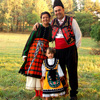
Bulgaria is an interesting Balkan country. Historically Bulgarians are ancestors of Turkic tribes called Bulgars, which mixed with a majority of Slavonic tribes in the area, inheriting it from the Thracians. The country is located at a crossroads between Europe, Asia and North Africa, which is why it has features of different cultures, along with the distinctive Slavic world. The country has an ethnically diverse population so there are groups with more Islamic and Turkish influence, such as the Muslim Bulgarians. We can say the same about the traditional costumes of Bulgaria and its clothing traditions. Today, the folk outfit of Bulgaria is a mix of ancient and modern pieces of clothing, with garments that reflect the peoples that brought them to the area. And this mix of diverse cultures and tastes is awesome!
- Details
- Category: Bulgaria
- Hits: 26381
 Tunisian vintage clothing is precious, not only because of all those gold (embroidery with golden threads, gold embellishments, etc.) but because of its historical value as well. In museums and private collections, we can find unique and unimaginable samples of the traditional outfit of Tunisia. They show us the wealth of Tunisian people and the skillfulness of local craftsmen. Here you are several pieces of vintage women's costumes. Some of them are familiar to our readers, and others may be a surprise.
Tunisian vintage clothing is precious, not only because of all those gold (embroidery with golden threads, gold embellishments, etc.) but because of its historical value as well. In museums and private collections, we can find unique and unimaginable samples of the traditional outfit of Tunisia. They show us the wealth of Tunisian people and the skillfulness of local craftsmen. Here you are several pieces of vintage women's costumes. Some of them are familiar to our readers, and others may be a surprise.
- Details
- Category: Tunisia
- Hits: 35513
 Indonesia is one of the most heavily populated Asian countries. More than 200 millions of people and over 300 different ethnic groups live in this country. That's why the traditions and folklore of Indonesia are diverse and unique. It is an island country which also influences the culture and customs of its citizens. Many traditional Indonesian costumes are originally the folk clothing of Java and Bali. Though, every ethnic group and minority in this country has its own clothing traditions, methods of making their national costumes, and tastes in adornments.
Indonesia is one of the most heavily populated Asian countries. More than 200 millions of people and over 300 different ethnic groups live in this country. That's why the traditions and folklore of Indonesia are diverse and unique. It is an island country which also influences the culture and customs of its citizens. Many traditional Indonesian costumes are originally the folk clothing of Java and Bali. Though, every ethnic group and minority in this country has its own clothing traditions, methods of making their national costumes, and tastes in adornments.
- Details
- Category: Indonesia
- Hits: 55444
Page 65 of 70
